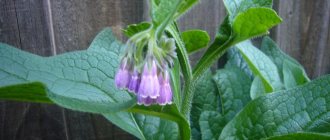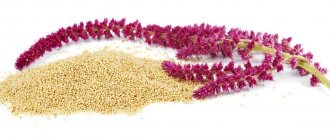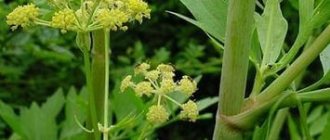Description
Plants of the Witch Hazel family grew on Earth long before our era.
Only a few managed to win the battle against time and survive natural disasters. The Witch Hazel genus was also among the “lucky” ones. True, in a very modest quantitative composition. If in the 20th century it consisted of 4-5 species, then in the current millennium, according to the classification system, only two have the right to bear a generic name - soft and virgin. Deciduous shrubs and trees with a shallow root system rarely grow to 5 meters in height. Spreading branches form a wide crown. The shoots are covered with thick “felt”. Numerous leaves are arranged alternately and sit on short petioles. The leathery leaf blades are ovoid in shape, with a rounded tip and jagged edges. They are painted dark green. Before leaf fall they turn yellow-red. Longitudinal veins are clearly visible.
Witch hazel blooms in early spring or late fall. Flowers collected in bunches appear in the axils of the leaves. Long thin petals look like spider legs, colored yellow, red, orange. When it gets colder, they curl up, and when it gets warmer, they straighten out again. Regular stamens with purple anthers and modified ones (staminodes) protrude from the center. Flowering lasts from two weeks to a month. The plant is pollinated by insects, mainly flies.
The fruits can be seen only after a year. That is, boxes resembling nuts with tiny horns are adjacent to new flowers on the branches. This property determined the name of the genus, translated from Greek as “together with the fruits.” Popularly, Witch Hazel is often called the magic or witch nut. After ripening, the boxes open and the seeds scatter to distances of up to 15 m from the mother plant.
Witch hazel is still rare in cultivation. Growing a tree or bush is a chance to acquire a plant curiosity that maintains year-round decorative value.
Beneficial properties of the “magic” culture
Witch hazel has long been used in folk medicine and cosmetology. To prepare potions they took :
- leaf plates;
- branches;
- buds;
- bark
It is these “ingredients” that contain the maximum useful components. Among other things, they are rich :
- organic acids;
- tannins;
- minerals;
- vitamins;
- essential oils.
The valuable properties of witch hazel directly depend on its chemical composition. The presence of flavonoids helps strengthen blood vessels. Bioactive compounds promote rapid wound healing. Organic acids and a set of vitamins have a beneficial effect on the immune system.
Traditional healers prepare medicinal potions from the components of the plant. A “drink” consisting of water and witch hazel bark helps with intestinal upset. For 1 liter of liquid you will need 2 tablespoons of raw materials. Cook it for about 15-20 minutes over moderate heat. The cooled “medicine” is filtered through gauze. Drink 200 g before meals. For external purposes, use liquid witch hazel extract mixed with olive oil. The drug is applied to the affected areas and left for about 6-8 hours.
For varicose veins, prepare a simple decoction: pour a tablespoon of crushed plant bark into a thermos. Pour boiling water over it. Leave for about an hour. Strain carefully. Moisten a gauze cloth and apply to problem areas in the morning and before bed.
Inflammatory processes are treated with a decoction prepared from the components:
- dry leaves;
- buds;
- boiling water.
Take one teaspoon of the crushed components. Pour boiling water (1 l). Leave for 15 minutes (in a thermos). The resulting liquid is filtered. Divided into 3 parts. Drink before every meal.
Witch hazel plant in cosmetology
The use of witch hazel in cosmetology has opened the way to healthy skin and curls. The plant is used in the preparation of shampoos, lotions, and tonic creams. Essential oil is used to combat dandruff.
Laboratory-obtained Virginia nut extract is used for such purposes.:
- cleansing the skin of the face and neck;
- getting rid of wrinkles;
- treatment of purulent rash;
- neutralize skin oiliness.
The amazing witch hazel plant has captivated exotic fans from all over the world with its beauty. Its flowering is pleasing to the eye when the earth rests under a snow “blanket”. The variety of species allows you to create original compositions on the site. Even inexperienced gardeners will enjoy simple planting and care. Medicinal drinks are prepared from the components of witch hazel.
Growing
Witch hazel can be grown as a tapeworm or as part of a group. It is very important to give each plant enough free space. You also need to choose an area protected from the winds.
These representatives of the flora do not get along well with their neighbors. They cannot resist plants with more powerful root systems. The best companions for Witch Hazels are bulbous plants.
Plant propagation is a rather complex process. Seeds need annual stratification. Germination takes the same amount of time. Germination rate is about 10%, and seedlings bloom only in the 7th year.
It is also possible to take green cuttings in the spring. After treatment with a root formation stimulator, the cuttings are placed in a substrate with the addition of perlite. Cover with polyethylene, place in a well-lit place and provide bottom heating. Ventilate periodically and gently moisten. After 2–2.5 months, carefully transplant into a container with compost. After a year, planting in open ground is permissible.
Description of witch hazel
In addition to the Latin name Hamamelis, this plant was popularly known as "Witch's hazel", "Witch's hazel". This name comes from the late flowering of witch hazel; the fruits ripen only by the summer of next year. Witch hazel grows wild in East Asia, the east coast of North America, and parts of the Caucasus. Witch hazel has very valuable medicinal properties, so in Europe it is often planted in “pharmaceutical gardens”.
Witch hazel leaves are rich in flavonoids and also contain a special group of substances - tannins. Tannins have a pronounced astringent property, as well as an antibacterial effect. As part of cosmetics, witch hazel softens the surface layer of the skin, helps tighten enlarged pores, and, thanks to its antibacterial properties, prevents inflammation. Witch hazel decoctions are often recommended for the care of skin prone to oiliness and inflammation.
First steps after purchase
It is recommended to purchase one-year-old seedlings with a closed root system. The older the plant, the more painful it is to transport and the worse it takes root.
The dimensions of the planting pit should be twice the size of the earthen ball; it is also necessary to take care of the drainage layer and add fertilizer to the depleted soil. Before planting, you should straighten the caked roots. When deepening, it is important to leave the root collar slightly above the soil level.
The planted plant is watered abundantly. It is advisable to cover the tree trunk circle with a 5-7 cm layer of mulch - rotted leaves or peat.
Varieties of spring witch hazel and rules for planting shrubs
A total of 4 species of plants are known. Through the efforts of breeders, several varieties of the spring variety have been obtained.
- Sandra. Features unconventional, purple leaves. Moreover, only young specimens are colored this way. Subsequently, the top of the plate turns green.
- Purpurea. This variety has burgundy colored inflorescences.
Variety Purpurea
- Autumn Embers. The variety is endowed with a faded color of the petals.
- Squib. The variety is distinguished by yellow shoots and a green flower cup.
- Lombards Weeping. The flowers have an original shape.
- Christmas Cheer. Buds on the shoots of shrubs appear the earliest.
Planting witch hazel is not particularly difficult. The place planned for growing the plant can be either open or lightly shaded.
Attention! You cannot plant shrubs in full sun. He cannot stand extreme heat.
Loam is considered the most suitable soil for witch hazel. This type of soil absorbs moisture well and retains it for a long time. The plant does not like calcareous rocks. It does not grow in such soil and can quickly die.
When planting, be sure to provide good drainage. To do this, the bottom of the pit is covered with stones or expanded clay. Ensuring good water permeability will prevent the roots from rotting.
The crop is planted either early in spring or late in autumn. They do this as follows:
- They dig a hole, which should be several times larger than the earthen ball on the seedling.
- A plant is placed in the center of the hole, the root is straightened and covered with a mixture of earth and humus.
- Lightly compact the planting and water well.
Advice. In order to fill the voids between the roots of the seedling well, after watering it needs to be carefully pulled up and slightly shaken.
After planting, the near-root zone is covered with a thick layer of hay or leaves. This will prevent the plant from dying in winter.
Secrets of success
Witch hazel grows well in partial shade and sunlit areas. In the second case, it is necessary to provide additional protection of the surface root system from direct sunlight.
The plant needs constantly moist, but not flooded soil. Moderate watering should be carried out regularly. It is recommended to mulch the tree trunk circle.
Witch hazel is fed in winter and spring. It is advisable to avoid using organic fertilizers. Complex minerals fully meet the needs of the plant.
Pruning is not included in the list of mandatory activities. As a rule, only damaged and weakened branches are removed. If the owner’s plans include the formation of a bush, then it is recommended to carry out the procedure immediately after flowering.
Caring for witch hazel and propagating exotics
Witch hazel cannot be called a whimsical plant, however, in order for the culture to feel good, some care rules must be followed.
- You need to water when the soil around it dries out. During dry periods, the bush is greatly depleted, so it is advisable to irrigate the entire crown in the morning and evening.
- Periodically it is necessary to loosen the soil at the roots of witch hazel.
- Shrub pruning is necessary in case of severe thickening of the crown. It is recommended to cut branches growing in the wrong direction into rings for two-year-old seedlings. In the spring, sanitary pruning should be done, removing frozen shoots.
- Up to 5 years, the plant should be provided with shelter for the winter. To do this, cover the ground around the trunk with hay or a thick layer of compost. This procedure will protect the roots from freezing.
Attention! Hybrid forms tolerate low temperatures much worse than the basic types of witch hazel.
Due to slow growth, the first buds can form on the plant after 5 or even 10 years. Only then will the bush be able to truly demonstrate its beauty.
Possible difficulties
When growing Witch Hazel, keep in mind that it grows very slowly. The plant reaches a two-meter height no earlier than 8–9 years of age.
Witch hazel is resistant to pest attacks and is not susceptible to disease. However, exceeding watering norms or the accumulation of liquid in the soil results in rotting of the roots and death of the plant. These representatives of the flora respond to a lack of moisture by curling and drooping leaves.
Even the most hardened Witch Hazels need to be wrapped for the winter at a young age.
It is recommended to prune frozen shoots of adult plants. Editorial team LePlants.ru
Hamamelis virginiana
It is a multi-stemmed shrub 3 meters high with a rounded and wide crown, as well as spreading branches. Its young shoots are covered with star-shaped pubescence. In mid-May, dense, dark green leaves appear, distinguished by an asymmetrical base and jagged edge. They have meek petioles that are slightly pubescent at the bottom. But the most mysterious and interesting effect can be observed in the fall. In the middle of this month, many flowers appear on the bush, which are collected in groups. Small, with 4 narrow petals and purple dust particles, slightly fragrant. The calyx of the flower has a brownish-yellow tint. The shrub itself begins to bloom from 8-10 years old for three weeks. In autumn, the shrub is very beautiful, thanks to its bright, lemon-yellow or slightly reddening leaves.
This species has been cultivated since 1736. In Russia, it is found mainly only in botanical gardens, but for gardeners it is a very rare plant.
One of the garden forms, Rubescens, has a yellow-brown flower cup and red leaves. At the same time, the shrub is very suitable for mass use, both for group and single plantings.
Soil for witch hazel
The soil for witch hazel must be fertile, so before planting it, the mixture should be prepared in advance. First of all, the plant needs to be provided with a good drainage layer, for which expanded clay is ideal. Then you need to remove the top fertile layer of garden soil to a depth of about 2-3 shovels and mix it with compost and humus.
Young shrubs can be planted in the resulting soil mixture. The trunk circle must be mulched with compost so that it protects the soil from drying out and provides the tree with useful substances.
Witch hazel blooming
The flowering time of the witch hazel depends on the variety. Some plants bloom in early spring before the leaves appear, while others bloom in the fall, delighting gardeners with their bright flowers until the first frost.
Inflorescences can have different shades: from light yellow to bright purple. Flower petals resemble twisted ribbons, which, depending on weather conditions, can curl or straighten out.
When witch hazel blooms, the garden area not only becomes bright and beautiful, but is also filled with a delicate, pleasant aroma that the plant exudes.
Pruning witch hazel
The shrub rarely needs pruning. It is only necessary when it thickens greatly. In this case, you need to wait for the witch hazel to bloom and thin it out, pinching off the branches directed inside the crown.
To give the plant a decorative shape, the gardener is recommended to take two-year-old seedlings and make a circular cut of the abnormally growing shoots. Thanks to this, it will be possible to evenly distribute the branches of the bush in the future.
Some people believe that there is no need to prune shrubs. But that's not true. If the root shoots are not removed in time, the plant will lose its decorative effect and become unkempt and thickened.
Types and varieties
There are only 4 types of witch hazel:
- spring;
- Japanese;
- Virginia;
- soft-haired.
Virginia and spring witch hazel are most suitable for the Russian climate.
soft-haired
It has the second name “Chinese witch nut”, as it comes from China. Soft witch hazel is covered with yellow flowers in early spring. Prefers slightly acidic and neutral soils. Does not tolerate prolonged drought, as well as stagnant moisture. During planting, it is better to use loamy soil with humus. Mulching is done using compost; the procedure helps get rid of weeds and retain moisture in the soil.
Virginia witch hazel
Popularly called the “Magic Nut”. In its natural environment it grows near rivers and forest edges. The shrub is capable of growing 3-5 m in height. The crown has a spherical shape. In autumn, the foliage changes color to yellow, rarely to red. Blooms in September. Loves sun and moist soils. In winter it needs shelter.
Witch hazel leaves and bark are often used in pharmacology and cosmetology. The components contained in it can prevent the formation of malignant tumors.
The fruit is represented by a seed capsule. Over time, it cracks, and the light seeds are blown by the wind over long distances. One seed pod contains only 2 black seeds.
Japanese witch hazel
Deciduous witch hazel is native to Japan. This variety of witch hazel was named after this. It blooms in March-April for 3-4 weeks. It reaches a height of 10 m. The branches are spreading. There is pubescence on young shoots. The leaf blade is dense, leathery, round or oval in shape. In autumn the foliage changes color to yellow-red. The inflorescences are small in diameter, reaching 2 cm in width. They are painted in a bright yellow tint. In the center of the flower there is a purple calyx. The fruit is also represented by a seed capsule with 2 seeds inside.
Witch hazel: contraindications
Although witch hazel is an amazingly useful and valuable medicinal plant, there are a number of contraindications to its use:
- individual intolerance and allergic reactions,
- pregnancy, lactation,
- children's age up to 7 years.
If you take drugs and medications with witch hazel , unpleasant side effects may occur: nausea and vomiting, digestive disorders. In case of an overdose, the symptoms are similar; they are also accompanied by a sharp decrease in blood pressure, dizziness and headache.
How to propagate witch hazel
Ornamental shrubs are propagated by seeds and cuttings. Hybrid forms do not lose their properties only when using the second option.
Cuttings happen like this:
- In mid-summer, cuttings are harvested. The tops of shoots with 3-4 internodes are suitable for this.
- The material is immersed in a root formation stimulator for several hours.
- At an angle of 45°, the cuttings are inserted into a loose and nutritious substrate.
- Moisten with a spray bottle.
- Cover with film and place in a warm, but not hot, shaded place.
- After 4-6 weeks, roots appear.
Witch hazel seeds are collected in September-November and immediately begin sowing. Boxes with crops are arranged for a cool winter in a room where the temperature does not drop below +2°C. Seed germination can be expected only in the second year in early spring. The seedlings are very delicate and require special care. Over the course of a year, seedlings rise by 20 cm, no more.
Spring witch hazel can be called a valuable plant. It is used in medicine and cosmetology. By planting this exotic plant on the site, lovers not only acquire a beautiful shrub, but also the opportunity to improve their health and improve their appearance.
author: Alexandra Butova
1. Rare and different
Very often, modern high-quality and by no means cheap cosmetic creams and lotions contain a product called “witch hazel”. Cosmetologists consider it very beneficial for the skin and use it to eliminate many dermatological problems. Surely this word is familiar to many, at least to women who regularly care for their skin. But how many people know what it is? So, witch hazel is another gift from the goddess Flora.
Plants from the genus Witch Hazel are large deciduous bushes or (much less often) small trees not exceeding three to five meters in height. This genus belongs to the witch hazel family (Hamamelidaceae) and consists of only five species - three American (Hamamelis ovalis, Hamamelis virginiana and Hamamelis vernalis), one Japanese (Hamamelis japonica) and one Chinese (Hamamelis mollis).
Witch hazels get their name from a Greek expression that translates as “together with the fruits,” due to the fact that the flowers and fruits of the previous harvest are adjacent to each other on the branches at the same time.
Witch hazel (Hamamelis virginiana) blooms in the fall, while other species bloom their unusual flowers in late winter.
Perhaps the rarest species is Hamamelis ovalis, a large-leaved endemic whose natural habitat occupies a very small area in the upper Mississippi River. Its flowers have a beautiful color, in which the whole spectrum of red shades is present: the flowers can be scarlet, pink, wine red, red-brown and even two-tone - red and yellow.
The flowers of its American cousin, Hamamelis vernalis, on the contrary, are small and inconspicuous. But this shortcoming is more than compensated for by its strong, pleasant aroma.
The Hamamelis mollis flower consists of four soft, thin ribbon-like petals, 1-2 cm long. Decorated with many yellow, orange, and sometimes red flowers, standing among unmelted snow, the bush looks very elegant and cheerful.
After flowering, witch hazel will form fruits that ripen for about eight months. The fruit is a two-chamber capsule about one centimeter long. Each half contains one 5mm black shiny seed. When the fruits are fully ripe, they burst, making a loud click, and forcefully “shoot” seeds that scatter over a distance of ten and sometimes more meters. For this feature, Americans nicknamed witch hazel the snapping nut.
Autumn foliage of Hamamelis mollis
Hamamelis mollis flower
The leaves of witch hazel are quite large, alternating, oval, slightly wavy at the edges; their length ranges from 4 to 16 cm and width from 3 to 11 cm, depending on the species. American species have larger leaves, while Asian species have smaller ones. Chinese witch hazel leaves are soft to the touch, which gives rise to its name: mollis means “soft.” In autumn, the leaves turn a very beautiful warm, golden orange color.
Witch hazels came to Europe only at the beginning of the 19th century. Brought from the USA to England by Peter Collinson (1694–1768), Hamamelis virginiana initially aroused the interest of local gardeners, but the modest American species, whose yellow flowers were lost among the bright autumn foliage, did not gain much popularity.
This witch hazel remained in demand only when creating forest parks consisting of typically American trees and shrubs, and subsequently began to be actively used as a scion when creating new cultivars.
However, after the famous plant collector, English botanist Charles Maries (1851–1902), brought Hamamelis mollis from the Chinese province of Jiujiang in 1879, the situation changed. The multitude of golden flowers shining on bare branches amid still-dormant nature made the vibrant Chinese witch hazel much more attractive than its American cousin.
But popularity was still far away.
The imported plants languished for several more decades on the outskirts of the Wich and Sons nursery, located in Chelsea, until they were finally noticed by the famous plant collector, an enthusiast who introduced about 2000 species of plants brought from different parts of Asia into Western culture, Ernest Henry Wilson (Ernest Henry Wilson, 1876–1930). With his participation, in 1902, the first seedlings of Chinese witch hazel appeared on the market.
Around the same period at the end of the 19th century, another species of witch hazel was brought from Japan - Hamamelis japonica. The Japanese species was larger than the Chinese one, the horizontal branches formed a lush, dense crown. Flowers bloomed on it just before Christmas. Large, with striped yellow petals and blood-scarlet or bright purple cups, they were very fragrant. The plant quickly gained popularity among British gardeners.
Later, many witch hazel cultivars were created, many of which are different variations of the hybrid Hamamelis x intermedia Rehder (H. japonica × H. mollis). The most famous are three varieties bred by Belgian breeders Helen and Robert de Belder, who worked in the famous botanical garden Kalmhout. The flowers of these cultivars are red in color: the bronze-red variety is named after its creator - Jelena, the variety that blooms with bright red flowers is named after the daughter of the breeders - Diane, and the most recent one - Livia. Its flowers are painted in a deep dark red color, and the name of the plant was given by the granddaughter of Belgian botanists.
Hamamelis japonica flower
2. Helpful and unpretentious
Flower of the hybrid Hamamelis × intermedia "Jelena"
For a long time, the leaves and bark of Hamamelis virginiana have been used by North American Indians for medicinal purposes. Currently, the plant extract of witch hazel, also commonly called simply witch hazel, is a component of many pharmacological and cosmetic products.
They are mainly used as an external remedy for wounds, bruises and tumors. Witch hazel leaf hydrosols (a hydrosol is an aqueous solution of essential oils, usually obtained by steam distillation from various parts of aromatic plants) are widely used in skin care. Being a strong antioxidant and an excellent astringent, witch hazel is often used as a natural remedy for psoriasis, eczema, acne, lubricated ingrown nails, and wiped on the face to prevent sweating. It is simply irreplaceable as an additive to aftershave lotions, as it promotes the rapid healing of wounds and cuts.
Lotion with a tincture of the leaves relieves skin inflammation caused by insect bites and poison ivy (Toxicodendron radicans) burns. They are used in the treatment of varicose veins.
The bark of Hamamelis virginiana produces a certain type of tannin called witch hazel tannin. It is these tannins that have an astringent, hemostatic, soothing and tonic effect on the body. Witch hazel tannins have also been found to suppress colorectal cancer cells.
Witch hazel bark extract is used as an internal remedy in the treatment of diarrhea, colitis, dysentery, hemorrhoids, vaginal discharge, excessive menstruation and internal bleeding.
Witch hazel is no less actively used in cosmetics. It is added to bath and shower gels and foams, shampoos and hair conditioners, cleansing lotions, deodorants, face and eye creams.
Unfortunately, witch hazels can rarely be found in our gardens and parks, not to mention kept as a house plant. It's a pity. These plants are not at all capricious.
They can withstand winter cold, but severe frosts can have a very negative effect on young plants, including their death. Therefore, during the first few years of their life, during severe winters they must be covered for the winter.
For planting, it is best to choose sunny places inaccessible to direct exposure to winds.
Witch hazels need well-draining soil with an adequate supply of moisture. Light soil with normal acidity (pH 4.5-6.5) and a large amount of organic matter, such as humus or compost, is ideal for these plants. However, they can grow quite normally in heavy clay or chalky soils, provided that they are regularly fertilized and have a drainage system.
Sometimes, due to the increased acidity of the soil, witch hazels develop chlorosis, their growth is stunted, and the leaves turn yellow. To eliminate this problem, it is best to use “Ferovit” (read more about “Ferovit” here).
Flower of the hybrid Hamamelis × intermedia "Diane"
Hamamelis mollis blooms in the Riga Botanical Garden
Witch hazels are sensitive to watering; they need a sufficient amount of moisture, especially during the flowering period. In snowless, dry winters, due to lack of moisture, plants may even lose flowers. And you need to be very careful about watering when growing witch hazel at home. To avoid drying out, it is best to cover the roots of the plant with mulch.
Witch hazels are one of the few plants that need to be fed during the uncharacteristic winter-spring period. Balanced complex fertilizers, as well as fish or bone meal, are well suited for this purpose.
Witch hazel bushes growing in open ground do not require special pruning. It is enough to promptly remove dead, damaged and weak branches.
If the size of the plant is limited by the condition of its content in the container, then you should remember that pruning must be done after flowering has ended. You need to learn to distinguish leaf buds - they are longer and narrower - from flower buds and try to remove branches with buds as little as possible, then next season even more flowers will appear on young shoots.
In commercial nurseries, witch hazels are propagated by grafting or budding the desired species or cultivar onto rootstock taken from Hamamelis virginiana. The rootstock and scion are grown from seeds.
Propagating witch hazels at home is not easy. In mid-spring, a cutting is taken from an adult plant from a young, non-lignified branch. The cutting is placed in a pot filled with a very light, well-draining mixture of 40 percent balanced compost, 30 percent perlite and 30 percent compost bark.
After eight to ten weeks, when the cutting has taken root, it is carefully moved into a pot of compost, where it should spend time until next spring. And only then can the young witch hazel be transplanted to a permanent place in ordinary soil.
In the Riga Botanical Garden, Hamamelis mollis has been growing for many years in front of the entrance to the large greenhouse - the Palm House. This year, with its cold, prolonged winter, it will greet visitors with its golden flowers, as if telling them in secret the main news - winter will end soon anyway..
Witch hazel: hemorrhoids
Witch hazel is effective in the fight against hemorrhoids, due to its anti-inflammatory, wound healing and vascular strengthening properties. Ointments, suppositories, purchased in a store or prepared independently using a decoction of the leaves of the plant, have a strengthening effect on the vascular walls of blood vessels, eliminate blood stagnation, improve blood circulation and fight tumors. In addition, witch nut heals cracks and relieves inflammation in the area of hemorrhoids.
In addition to witch hazel , propolis (in the form of suppositories), mullein and St. John's wort can help combat this unpleasant disease.
Witch hazel growing from seeds
Seed material is collected in mid-autumn and immediately sown. Then the box with the sown seeds is placed in a cool room with a temperature of at least +2 degrees until spring.
Seeds will begin to germinate only in the second year after planting. After the young shoots appear, they need to be watered on time and a favorable microclimate must be maintained. Over the course of a year, young plants grow no more than 20 centimeters.
Ways to use witch hazel
For medicinal and cosmetic purposes, an extract is obtained from the bark and leaves of witch hazel plants.
However, it is not used in such a concentrated form. The extract is included in a variety of medicinal products:
- Ointment, gel or cream - this means a medicinal form. 1 g of ointment contains 100 mg of extract. The base of the cream is Vaseline. Various uses: dermatitis, insect bites, rosacea, diaper rash, burns, wounds;
- Candles – in suppositories 57 mg. The base is solid fat. This form is used to treat hemorrhoids, as well as to stop intrauterine or hemorrhoidal bleeding;
- The extract, or more precisely, the tincture, contains up to 4% concentrated extract. Includes essential oils of arnica, ivy, hops. The tincture is used in the form of compresses and rubbing. Helps with dermatitis, emphysema, bruises, hematomas. The remedy is prescribed for migraines: the oil is applied to the temples and the back of the head;
- Napkins or patches are soaked in witch hazel infusion containing oil extract of sweet clover, cloves, and linden. Used as an application. Napkins are applied to the affected areas of the skin, as well as to the anal area for hemorrhoids;
- Granules are a matrix tincture of sucrose. Prescribed for varicose veins, thrombophlebitis, inflammation of the ovaries and hemorrhoids.
At home, decoctions and infusions are prepared from the bark and leaves. The concentration of nutrients in them is lower, but their medicinal properties are also significant.
In any form, witch hazel is used externally only.
How is witch hazel used in cosmetology?
For these purposes, the plant extract is produced in gelatin capsules, in the form of a dry extract and as part of a variety of products: lotions, shampoos, creams, emulsions and others. They produce whole series of cosmetic preparations containing extract and oil.
They will apply creams, ointments and lotions in accordance with the problem being solved and taking into account the concentration. Thus, to treat purulent acne, an ointment with a high content of extract is required, and to narrow pores, a cream with a small concentration of the active substance is suitable.
Creams, shampoos and gels are used for the following purposes:
- Reduces skin pores, removes excess oil. Normalization of the sebaceous glands - tannins contained in witch hazel provide these properties;
- Reduced swelling - the cream helps to get rid of not only bruises and bags under the eyes, but also more serious swelling on the legs, even with varicose veins;
- Witch hazel essential oils stimulate epidermal renewal and promote collagen production. The effect of anti-aging creams is based on this;
- Normalization of water and fat balance - drugs restore normal skin acidity and regulate sebum production. This is relevant for those with oily and normal skin with a lack of moisture;
- Intermediate between caring and therapeutic agents are lotions and ointments for the treatment of purulent acne, eczema, psoriasis;
- As part of shampoos, oil allows you to get rid of seborrhea, both dry and wet.
Witch hazel products are intended for the care of mature skin. At a young age, only formulations for the treatment of acne and seborrhea are used.
Replanting witch hazel
The plant cannot be replanted often, due to the fact that the shrub is characterized by extremely slow growth. It is necessary to move the plant to a well-lit, heated area without drafts or stagnant water. If the location is chosen incorrectly, the witch hazel may stop growing and bearing fruit, and in the worst case, the bush will die.
The soil for witch nuts should be loose and fertile. It is better to replant the shrub with its original clod of earth, carefully transferring it to a previously prepared hole. It will take about six months for witch hazel to take root in a new place and take root.
Witch hazel: shampoo
Witch hazel extract is also added to hair care products, namely shampoos. The shampoo is suitable for all hair types, and especially for combination hair types (oily roots, dry ends). Witch hazel extract regulates the functioning of the sebaceous glands and protects the scalp from microdamage. Important: these shampoos are suitable for children's hair, make it soft, manageable and prevent tangling.
If the hair is in very poor condition, then additional therapy should be carried out using cosmetic oils - argan oil and avocado oil.











